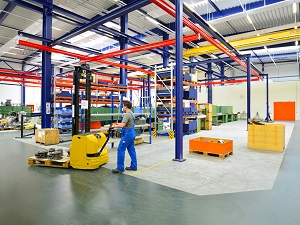Motorized pallet jacks or manual pallet jacks are found in nearly every warehouse and are essential in many manufacturing and distribution work environments. These jacks can easily lift 2,500 pounds or more, making swift work of heavy loads that need to be moved.

Pallet jacks are commonly regarded as being safer than a forklift, but there are still safety hazards that all pallet jack operators should be aware of, including:
- Foot Injuries – when loads are dropped or the pallet jack moves over foot
- Back Trauma – from moving a loaded pallet jack or adjusting a heavy load
- Shoulder Strain or Dislocation – when the pallet jack is pulled too forcefully
- Bruising or Lacerations – tripping hazards caused by the pallet jack forks
- Property Damage – when the heavy load strikes a corner, column, wall or other stationary object
OSHA General Industry Standard 1910.178 contains safety requirements relating to fire protection, design, maintenance, and use of fork trucks, tractors, platform lift trucks, motorized hand trucks, and other specialized industrial trucks.

Perform a basic pallet jack and workplace inspection at the beginning of every shift or before using the pallet jack for the first time each work day. At minimum, look for the following:
- Survey the workplace the pallet jack may be used and clean up any spills and move anything that could later be in the path of a moving pallet jack
- Inspect the wheels to ensure they are rolling easily and do not have flat spots
- Check the forks before loading to ensure they are not damaged or defective
- Make sure there are no fluid leaks coming from the pallet jack
- Test the controls, handles, levers and horn on the pallet jack to make sure everything is working properly before attempting to add a load
- Ensure the electric plug and cord on a motorized pallet jack is not missing prongs and the cord is not frayed

If any defects or issues are found during the inspection do not operate the pallet jack and report immediately.
- Report damaged or excessively worn pallet jacks.
- Report pallet jacks with a failing hydraulic unit.
OSHA General Industry Standard 1910.178(q)(7) Industrial trucks shall be examined before being placed in service, and shall not be placed in service if the examination shows any condition adversely affecting the safety of the vehicle. Such examination shall be made at least daily. Where industrial trucks are used on a round-the-clock basis, they shall be examined after each shift. Defects when found shall be immediately reported and corrected.
Wear required PPE when operating any pallet jack.
- Always wear gloves when handling pallets.
- Hard-toe boots are recommended when working with heavy loads or heavy equipment like pallet jacks.
- Be aware of pinch points to avoid hand injuries
OSHA General Industry Standard 1910.178(o)(1) Only stable or safely arranged loads shall be handled. Caution shall be exercised when handling off-center loads which cannot be centered.
- Know the maximum load limit of the pallet jack you are operating. Never overload a pallet jack!
- Ensure loads are stacked evenly on the forks before moving the pallet jack.
- Inspect the floors where the pallet jack will be driven to ensure the path is clear.
- Keep loads as close to the ground as possible for transport.

- Operate the pallet jack at a safe speed. Start moving slowly and come to a stop slowly.
- Do not steer pallet jacks onto uneven surfaces and avoid steep inclines.
- When possible, push pallet jacks during transport. Pulling may allow better maneuverability but puts considerable strain on the back. Pushing uses stronger leg muscles and keeps the back straight.
- Never try to stop a pallet jack with hands or feet, this could cause serious injury, especially with a very heavy load.
OSHA General Industry Standard 1910.178(n)(8) Under all travel conditions the truck shall be operated at a speed that will permit it to be brought to a stop in a safe manner.
- When transporting a load, keep the jack control in the ‘neutral’ position.
- Watch for clearance on both sides of the load.
- Move slowly enough that you can keep the load under control.
- Do not ride on the forks of a pallet jack or allow others to be carried. Don’t stand on a pallet jack.

Pallet jacks may seem simple enough to use, but no employee should operate a pallet jack unless they have been trained on safe operation of the pallet jacks used in their current workplace.
OSHA General Industry Standard 1910.178(l)(1)(i) The employer shall ensure that each powered industrial truck operator is competent to operate a powered industrial truck safely...

When descending any ramp, always keep the pallet jack in front of you. Never pull a pallet jack down any incline!
Slow down at aisle intersections, blind corners and elevators. Sound the horn and give pedestrians the right of way.
- Unused pallet jacks are a major trip hazard.
- When not in use, pallet jacks should be rolled into an area that does not have pedestrian traffic.
- Do not store pallet jacks in any area where they block fire extinguishers, emergency equipment or any exits.
- Park unused pallet jacks on a level surface, with the forks lowered.


